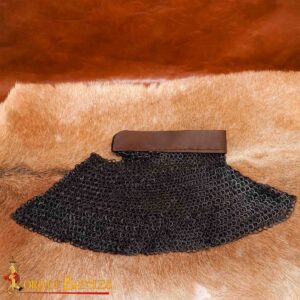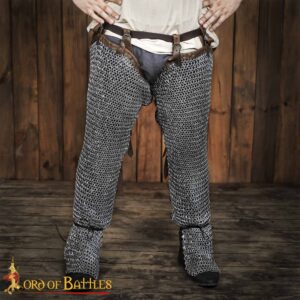$14.99
153 in stock
Forge your armor, one ring at a time—built for crafting, repair.
• Made from high-tensile mild steel for enhanced strength and resistance
• Butted ring design, 9mm inner diameter for historical accuracy
• Crafted with 16-gauge (1.6 mm) wire thickness
• Raw steel finish offers authentic medieval appearance
• Ideal for chainmail construction, repairs, and LARP gear
Take your medieval armor project to the next level with this 1kg pack of butted chainmail rings, crafted from high-tensile mild steel. Designed for superior durability over standard-grade mild steel, these rings hold their shape well, reducing distortion during weaving and wear. Perfect for both novice armorers and seasoned reenactors, this set offers an excellent balance between strength, authenticity, and workability.
The 9mm inner diameter is a classic size widely used across historical European chainmail designs. The 16-gauge wire (approx. 1.6 mm thick) provides a pleasing mix of flexibility and structural integrity, suitable for building mail shirts, coifs, aventails, chausses, and more.
Historical Note:
Butted rings became especially common during later medieval periods and in regions where riveted mail was cost-prohibitive or unavailable. Though not as rugged as riveted types, butted mail was widely worn over padded garments, used in pageantry, and integrated into costume-grade armor. Today, it remains a popular choice for reenactment, LARP, and display pieces due to its easier handling and affordability.
Whether you’re constructing your own hauberk or experimenting with chainmail patterns like European 4-in-1 or 6-in-1, this pack gives you the material freedom to craft, repair, or prototype as you wish.
MEASUREMENTS:
• Inner Ring Diameter: 9 mm
• Wire Thickness: 16 gauge (~1.6 mm)
• Total Weight: Approx. 1 kg / 2.2 lbs
USAGE:
• Building chainmail shirts, coifs, aventails, and leg armor
• Fixing damaged sections in existing mail gear
• Exploring historical weaving techniques
• LARP, cosplay, and theatrical costume design
• Museum-quality replicas and experimental archaeology
INSTALLATION TIPS:
• Use two pliers to open and close rings cleanly
• Aim for slight overlap in closures to boost strength
• Begin with small sample patches to refine your technique
• Monitor pattern consistency and tension during assembly
CARE INSTRUCTIONS:
• Keep stored in a dry environment to prevent rust
• Apply light oil or wax if surface oxidation occurs
• Wear gloves or use clean hands to minimize moisture exposure
• Avoid storing in contact with acidic or damp materials ⭐











Take your medieval armor project to the next level with this 1kg pack of butted chainmail rings, crafted from high-tensile mild steel. Designed for superior durability over standard-grade mild steel, these rings hold their shape well, reducing distortion during weaving and wear. Perfect for both novice armorers and seasoned reenactors, this set offers an excellent balance between strength, authenticity, and workability.
The 9mm inner diameter is a classic size widely used across historical European chainmail designs. The 16-gauge wire (approx. 1.6 mm thick) provides a pleasing mix of flexibility and structural integrity, suitable for building mail shirts, coifs, aventails, chausses, and more.
Historical Note:
Butted rings became especially common during later medieval periods and in regions where riveted mail was cost-prohibitive or unavailable. Though not as rugged as riveted types, butted mail was widely worn over padded garments, used in pageantry, and integrated into costume-grade armor. Today, it remains a popular choice for reenactment, LARP, and display pieces due to its easier handling and affordability.
Whether you’re constructing your own hauberk or experimenting with chainmail patterns like European 4-in-1 or 6-in-1, this pack gives you the material freedom to craft, repair, or prototype as you wish.
MEASUREMENTS:
• Inner Ring Diameter: 9 mm
• Wire Thickness: 16 gauge (~1.6 mm)
• Total Weight: Approx. 1 kg / 2.2 lbs
USAGE:
• Building chainmail shirts, coifs, aventails, and leg armor
• Fixing damaged sections in existing mail gear
• Exploring historical weaving techniques
• LARP, cosplay, and theatrical costume design
• Museum-quality replicas and experimental archaeology
INSTALLATION TIPS:
• Use two pliers to open and close rings cleanly
• Aim for slight overlap in closures to boost strength
• Begin with small sample patches to refine your technique
• Monitor pattern consistency and tension during assembly
CARE INSTRUCTIONS:
• Keep stored in a dry environment to prevent rust
• Apply light oil or wax if surface oxidation occurs
• Wear gloves or use clean hands to minimize moisture exposure
• Avoid storing in contact with acidic or damp materials ⭐








Enjoy 24/7 customer support from our dedicated team. We're always here to assist you with any questions or issues, ensuring a smooth and reliable shopping experience, anytime, anywhere.
Global shipping from our world-wide warehouse network. We guarantee fast and secure deliveries to any location, ensuring your medieval gear arrives quickly, no matter where you are.
Shop without worrying about hidden fees. All international orders are free from customs duties, making your purchase simple and hassle-free, with no extra charges.











You are browsing from . For a better experience, we recommend visiting Medieworld.